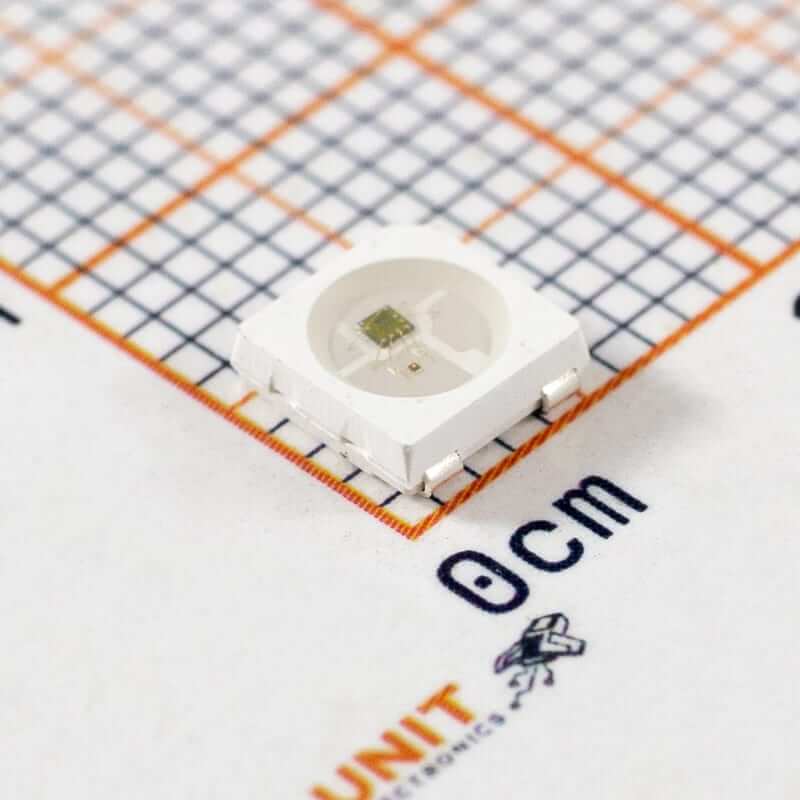WS2812 Control#
Harness the power of WS1280 LED strips with the PULSAR C6 board. Learn how to control RGB LED strips and create dazzling lighting effects using MicroPython.
This section describes how to control WS2812 LED strips using the PULSAR C6 board. The PULSAR C6 board has a GPIO pin embebbed connected to the single WS2812 LED.
PIN |
GPIO ESP32C6 |
|---|---|
DIN |
8 |

Fig. 21 WS2812 LED Strip#
Code Example#
Below is an example that demonstrates how to control WS1280 LED strips using the PULSAR C6 board
from machine import Pin
from neopixel import NeoPixel
np = NeoPixel(Pin(8), 1)
np[0] = (255, 128, 0) # set to red, full brightness
np.write()
#include <Adafruit_NeoPixel.h>
#define PIN 8
Adafruit_NeoPixel strip = Adafruit_NeoPixel(1, PIN, NEO_GRB + NEO_KHZ800);
void setup() {
strip.begin();
strip.setPixelColor(0, 255, 128, 0); // set to red, full brightness
strip.show();
}
#include <stdio.h>
#include "freertos/FreeRTOS.h"
#include "freertos/task.h"
#include "driver/rmt_tx.h"
#include "esp_err.h"
void app_main(void) {
rmt_channel_handle_t tx_channel = NULL;
rmt_tx_channel_config_t tx_config = {
.gpio_num = GPIO_NUM_8,
.clk_src = RMT_CLK_SRC_DEFAULT,
.resolution_hz = 10000000, // 10MHz resolution, 1 tick = 0.1us
.mem_block_symbols = 64,
.trans_queue_depth = 4,
.flags.invert_out = false,
.flags.with_dma = false,
};
ESP_ERROR_CHECK(rmt_new_tx_channel(&tx_config, &tx_channel));
ESP_ERROR_CHECK(rmt_enable(tx_channel));
rmt_encoder_handle_t bytes_encoder = NULL;
rmt_bytes_encoder_config_t bytes_encoder_config = {
.bit0 = {.level0 = 1, .duration0 = 3, .level1 = 0, .duration1 = 9}, // 0: ~0.3us high, ~0.9us low
.bit1 = {.level0 = 1, .duration0 = 9, .level1 = 0, .duration1 = 3}, // 1: ~0.9us high, ~0.3us low
.flags.msb_first = true,
};
ESP_ERROR_CHECK(rmt_new_bytes_encoder(&bytes_encoder_config, &bytes_encoder));
rmt_transmit_config_t tx_trans_config = {
.loop_count = 0,
};
uint8_t r = 255, g = 0, b = 0;
while (1) {
if (r == 255 && g < 255 && b == 0) {
g++;
} else if (g == 255 && r > 0 && b == 0) {
r--;
} else if (g == 255 && b < 255 && r == 0) {
b++;
} else if (b == 255 && g > 0 && r == 0) {
g--;
} else if (b == 255 && r < 255 && g == 0) {
r++;
} else if (r == 255 && b > 0 && g == 0) {
b--;
}
uint8_t color_data[3] = {g, r, b};
// printf("%d %d %d\n",r,g,b);
ESP_ERROR_CHECK(rmt_transmit(tx_channel, bytes_encoder, color_data, sizeof(color_data), &tx_trans_config));
ESP_ERROR_CHECK(rmt_tx_wait_all_done(tx_channel, portMAX_DELAY));
vTaskDelay(pdMS_TO_TICKS(10));
}
}
Tip
for more information on the NeoPixel library, refer to the NeoPixel Library Documentation.
